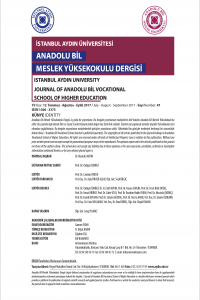Fotovoltaik panel verimliliği ve maksimum güç noktası izleme
Fotovoltaik Güneş Panelleri, Fotovoltaik Enerji, Maksimum Güç Noktası İzleme, Fotovoltaik Panel Verimliliği, MPPT
Photovoltaic panel efficiency and maximum power point tracking
Photovotaic Solar Panels, Photovoltaic Energy, Maximum Power Point Tracking, Photovoltaic Panel Efficiency, MPPT,
___
- Altaş, İ. H., (1998). Fotovoltaj güneş pilleri: yapısal özellikleri ve karakteristikleri, Enerji, Elektrik, Elektromekanik-3e, 47, pp.66-71.
- Asim, M., Tariq, M., Mallick, M. A., Ashraf, I., Kumari, S., Bhoi, A. K., (2018). Critical evaluation of offline MPPT techniques of solar PV for stand-alone applications, in Advances in Smart Grid and Renewable Energy: Proceedings of ETAEERE-2016, (pp. 13-21), Springer Nature Singapore, Singapore.
- Boztepe, M., (2017). Fotovoltaik Güç Sistemlerinde Verimliliği Etkileyen Parametreler, IV. İzmir Enerji Verimliliği Günleri, 19-20, İzmir
- Chikate, B. V., Sadawarte, Y., Sewagram, B. D. C. O. E., (2015). The factors affecting the performance of solar cell. International journal of computer applications, 1(1), 0975-8887.
- Çakır, M., Türkay, Y., (2023). Maksimum Güç Noktası Takibinde Kullanılan Değiştir Gözle ve Artan İletkenlik Algoritmalarının Karşılaştırmalı Analizi. In International Conference on Trends in Advanced Research (Vol. 1, pp. 193-198), Konya.
- Deniz E., (2013). Güneş Enerjisi Santrallerinde Kayıplar, III. Elektrik Tesisat Ulusal Kongre ve Sergisi Bildirileri, İzmir
- Duman, S., Yörükeren, N., Altaş, İ. H., (2014). Fotovoltaik Enerji Sistemlerinin Modellenmesi, Benzetimi ve Uygulaması. İleri Teknoloji Bilimleri Dergisi, 3(1), pp.9-23.
- Duyan, F., Bayrakdarlar, K. P., (2022). Enerji Etkin Bina Tasarımında Yapı Elemanı olarak Fotovoltaik Sistemler. Mimarlık ve Yaşam, 7(3), 965- 980.
- Ersöz, S., Onat, N., (2009). Fotovoltaik Sıstemlerde Maksimum Güç Noktası İzleyici Algoritmalarının Karşılaştırılması, V.Yenilenebilir Enerji Kaynaklar Sempozyumu, 50-57, Diyarbakır.
- Hadaj, P. and Nowak, M., 2016. “Mppt Algorithms Used In Photovoltaics. Advances in IT and Electrical Engineering, 24(35-2), pp.5- 17.
- Koç, A., Yağlı, H., Koç, Y., Uğurlu, İ., (2018). Dünyada ve Türkiye’de Enerji Görünümünün Genel Değerlendirilmesi. Mühendis ve Makina, 59(692), 86-114.
- Keskin, Y. E., (2014). Fotovoltaik sistemlerde maksimum güç noktası izleme yöntemlerinin karşılaştırılması, Yüksek lisans tezi, Kocaeli Üniversitesi, Fen Bilimleri Enstitüsü, Kocaeli.
- Öztürk, H., (2017). Güneş Enerjisinden Fotovoltaik Yöntemle Elektrik Üretiminde Güç Dönüşüm Verimi ve Etkili Etmenler, TMMOB Elektrik Mühendisleri Odası V. Elektrik Tesisat Ulusal Kongre ve Sergisi, İzmir.
- Peled, A., Appelbaum, J., (2016). Minimizing the current mismatch resulting from different locations of solar cells within a PV module by proposing new interconnections. Solar Energy, 135, 840-847.
- Putri, R. I., Wibowo, S., Rifa’i, M., (2015). Maximum power point tracking for photovoltaic using incremental conductance method. Energy Procedia, 68, 22-30.
- Ünlü, M., (2015). Fotovoltaik Sistemlerde Parçalı Gölgelenme Durumlarında Maksimum Güç Noktası İzleyebilen Şebeke Bağlantılı Yeni Bir Evirici Tasarımı ve Uygulaması, Doktora Tezi, Kocaeli Üniversitesi Fen Bilimleri Enstitüsü, Kocaeli.
- URL 1 https://group.met.com/en/mind-the-fyouture/ mindthefyouture/when-will-fossil-fuels-run-out, (Erişim tarihi: 22.05.2023).
- URL-2 https://www.gosolartexas.org/solar-equipment, (Erişim tarihi: 04.05.2023).
- URL-3 https://www.pveducation.org/pvcdrom/properties-of-sunlight/ azimuth-angle (Erişim tarihi: 04. 05. 2023)
- ISSN: 1306-3375
- Başlangıç: 2006
- Yayıncı: İstanbul Aydın Üniversitesi
Türk Mutfağında Zeytin Ve Zeytinyağının Kullanımı Ve Sağlık Faydası
Kara Yüzey Sıcaklığının ARIMA Yöntemiyle Modellenmesi ve Gelecek Tahmini: Antalya Uygulaması
Kentsel ısı adası, sıcaklık dalgaları ve halk sağlığı ilişkisi
Fonksiyonel bir içecek şalgam suyunun üretimi ve muhafazası
Burç ERSOY, Nuray CAN, Aysun SAĞLAM
Vanilya ve farklı alanlarda kullanımı
Ekin DİNÇEL KASAPOĞLU, Meryem BADAYMAN
Veri Madenciliği Analiz Yöntemleriyle İngilizce Hazırlık Sınıfı Başarı Analizi
Zeynep AYTOLU KÜLAHCİ, Zafer ASLAN
Fotovoltaik panel verimliliği ve maksimum güç noktası izleme
